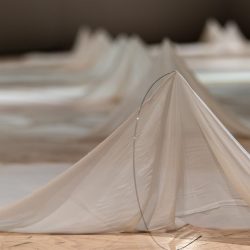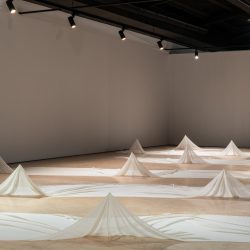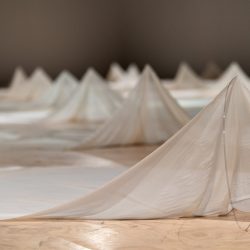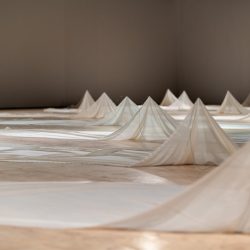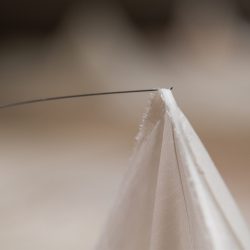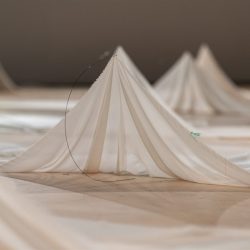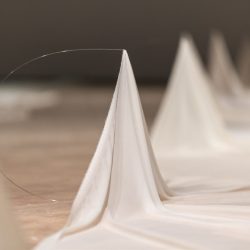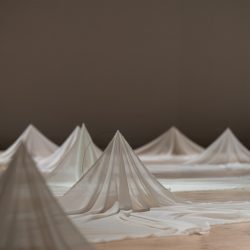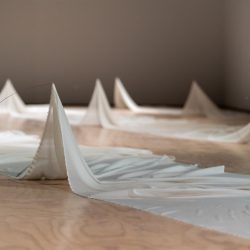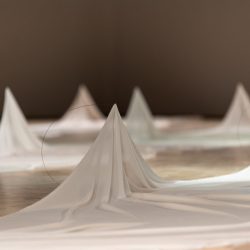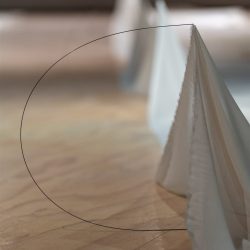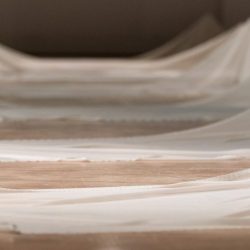Walk on Waking
John Ward Knox
17 March 2024 – 16 June 2024
This exhibition started in the dirt, in spring. The daffodils were already through—bright yellow bugles sounding reveille to the seeds and tubers still dormant in the earth. Deciduous trees were beginning to clothe themselves again, first in a sheer green shimmer over their winter-dark bones and then, all in a hurry, in blotches and patches and fingertip flourishes. Every tree dresses itself differently; some dowdily primp the ruffles of their winter coat back to newness while others, such as the magnolia, dress first in jewellery and stand naked against the mirror of the sky, before condescending to convention.
Everywhere new life was emerging and I wished to create a celebration of that vegetal flush of optimism, sugars and starches stored in seed and root showing us the new tilt of the earth’s axis. I wanted to recognise the tiny forces at work everywhere, pushing and pulling in relation to the constants at the core of it all: the gravitation of our iron heart and the levity of our ambition.
Each day during the making of this show I would walk in the nearby hills, along metal and dirt roads, under the keen watch of kāhu and the inky, still gaze of cattle. The roads pass wetlands, rail corridors, farmland, macrocarpa plantations, gorse-filled gullies, bare outcroppings of rock, a few country houses with fruit trees, concrete culverts and views of the soft curve of the horizon. All around me green things were burying their pale roots into the earth and this was going to be the name and content of the show: Roadside Growth.
I wanted to witness how these marginal plants flourished. I had an idea of the gallery as an industrial yard—a space reserved for the exceptionally hardy and the exceptionally delicate, for rarified and transmissible ideas. I wanted to show off the spectacular tenacity and sculptural ingenuity of these plants—the ways they grow in, and interact with, a world that is hardened to them. This was to be a sculptural celebration of form and diversity, of geometry, of physics—a series of tiny, unexceptional guides to the universe.
But then, something shifted. The heavy tread of humanity is felt as much in the earth as the roots of these plants. Because the violence of our species is too loud to ignore, the exhibition changed and gained a new name: Walk on Waking.
A wake can be something that you leave behind you; in this case, the stillness of reflection, the cultivation of complexity and the transmission of ideas in good faith.
We are living through a human moment, which means bearing witness to inhumanity—politically, socially, militarily. As a species we are bloodletting again, a habit that we cannot seem to shake. Because we are living through a time of uncertainty, we seem to lack a future to hang our hats on. We instead make one from nothing, by historicising ourselves, by othering and gathering around cloistered ideals and identities, by fetishising power and innocence. We recode small and large acts of violence as self-preservation. We begin to hoard: money, land, possessions, grievances, righteousness, piety. These become tokens of collective fear, expressed individually against uncertainty.
The exhibition leaves behind celebration for mourning, a small departure because the two are so closely intertwined. There can be no mourning without a remembered celebration. Materially, the show has also been simplified to two components: silk and steel.
Silk is a material of transformation. It starts as a mineral wealth that a mulberry tree finds. These minerals are made accessible by water, leached and pried and freed from the dirt. A tree is always seeking a solution. Solution becomes aspiration as moisture is transported from earth to leaf. Emerging from an egg, a silkworm will begin to engorge itself on this abundance. Once fattened enough it will spin a protective cocoon – a single thread of protein which hardens in contact with the air. We learned to interrupt this process to take upon ourselves the silkworm’s material labour and clothe ourselves in the product of transformation. Silk has become an exemplar of something human. A mixture of practical and symbolic conceit – luxury.
Steel has a different story. Ferrous rock or fallen meteor, both were uplifted from the earth. We have experimented with this material, and we have made it sing all the tones of humanity – the high notes of artistry, the middle notes of industry and the low notes of warfare.
We have added carbon to create tensility: the combination of strength and flexibility. Whileput under pressure, the piano wire used in this exhibition retains its original state and, if released from pressure, will rebound to it.
Tensility is a characteristic that creates a type of grace. This is what I had hoped to show from my observations of the weeds and scrub of the roadside – the ability to yield and the tenacity to rebound. We have always extracted and transformed, sometimes to balance the world and sometimes to pillage it. I hope that in presenting these two materials I am telling a human story, reconciling our cyclic cruelty and fragile veil of civility with optimism. We are impossible creatures, and we leave both pain and beauty in our wake.
